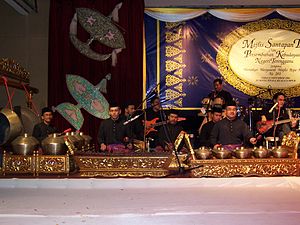 |
||
picture courtesy of www.google.com THE HISTORY OF GAMELAN' S ORIGINS
source: http://duniamuzzikku.blogspot.com/p/nota-muzik.htmlG THE HISTORY OF MALAY GAMELAN In 1811, an exquisite dance performance, accompanied by an ensemble of brass instruments, was brought from the Riau-Lingga court to enliven a royal wedding which took place in Pekan, Pahang. Since then, this performing art, now known as the Malay gamelan, had developed into an exclusive entertainment for royal pleasure in the Pahang and Terengganu courts.
Between 1914 and 1942, the love and effort devoted by the royal couple of Terengganu, Sultan Sulaiman Badrul Alam Syah and Tengku Ampuan Mariam, had carried the Malay gamelan into its glory days. However, the demise of the patrons and World War II had caused the Malay gamelan to almost disappear, turning it into a hidden treasure.
24 years later, Tan Sri Haji Mubin Sheppard, a man on a mission to preserve Malay architecture, stumbled upon the long abandoned gamelan instruments, locked away in Istana Kolam. That year was 1966. This finding lead to a reunion of the former musicians, headed by Pak Mat and the re-establishment of new dancers under the guidance of Mak Nang, once a primadona of the court. Hence, the Malay gamelan was reborn and from a prefatory appearance in Istana Kolam, it was brought to University of Malaya, Kuala Lumpur to be performed in public for the very first time.
The Malay gamelan has now lifted its veil to audience and listeners beyond the royal circle, thus allowing the beauty and splendor of this precious heritage to be enjoyed and explored by the generation to come. Tan Sri Moben Sheppard was responsible for
introducing gamelan outside of the palace gamelan music in the 1970s. Since
then, several modifications in the Malay features have happened to this music. Now it is
known as the Malay gamelan, especially when presented in a formal ceremony
celebrating the dignitaries, foreign leaders and tourists.
|
||
